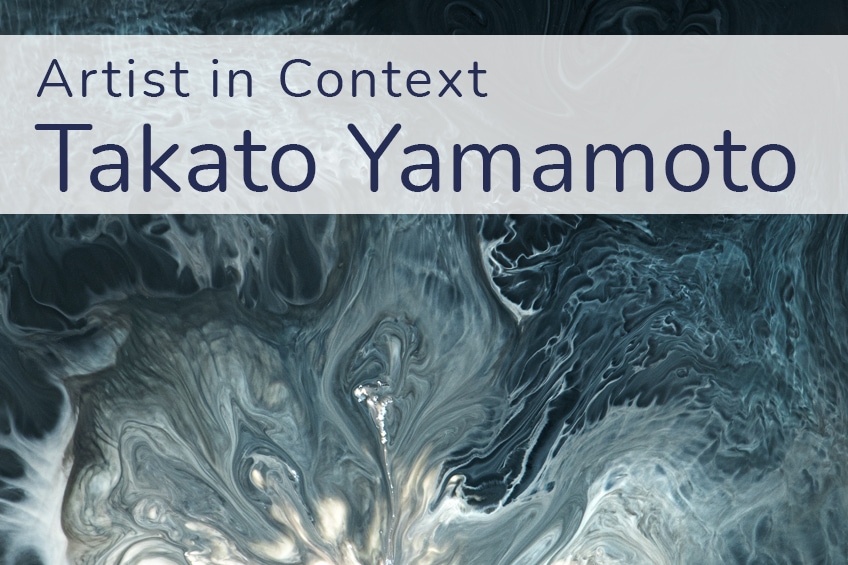Takato Yamamoto – Exploring the Erotic World of Takato Yamamoto’s Art
Takato Yamamoto is one of those artists that creates incredible artwork despite very little being known about their lives. Takato Yamamoto’s art is defined as Heisei Estheticism, a style that he was responsible for pioneering. Takato Yamamoto the artist has had his work featured in magazine covers, short stories, and novels.
Takato Yamamoto’s Biography
Very little information can be found about the enigmatic artist Takato Yamamoto. However, the best effort has been made to piece together what is available. Here is our brief overview of Takato Yamamoto’s biography.
| Nationality | Japanese |
| Date of Birth | 15 January 1960 |
| Place of Birth | Akita Prefecture, Japan |
| Associated Style | Heisei Estheticism |
Life and Training
Takato Yamamoto was born in Japan’s Akita Prefecture in 1960. Yamamoto then received his degree in painting from the University of Tokyo Zokei in 1983. From 1991 until 1993, he explored the ukiyo-e style to ultimately identify his unique approach, which he dubbed “Heisei Estheticism.” He has illustrated several novels, short tales, and magazine covers.
His debut show, “Heisei Esthetics,” was presented in 1998 at Ginza’s Creation Gallery G8. This was followed by many volumes released by Editions Treville from 1998 to 2006, as well as international shows in 2005, such as those at Mondo Bizzarro Gallery in Rome.
Takato Yamamoto’s art has received widespread appreciation in Japan for his technical mastery and fascinating, sensuous representation of women.
After working as a professional artist in advertising, Yamamoto began establishing his distinct visual style in the early 1990s. He had his official debut in an art gallery in Ginza, Tokyo, within the next few years, and he immediately established a demand for collections of his illustrations. Yamamoto utilizes a dark color palette and incorporates gothic characters such as demons and Lolita-esque characters into his works.
Takato Yamamoto’s Art Style
Takato Yamamoto is well recognized for creating a distinct style known as “Heisei aestheticism,” which combines inspirations from Japanese ukiyo-e art with European gothic art to produce gloomy, yet appealing images. His surrealistic and extremely detailed paintings frequently explore themes of murder, death, and sensuality, resulting in disturbing and profoundly metaphorical imagery. Yamamoto’s art frequently deals with vulgar issues, yet does it in startlingly subtle ways.
This subtlety entices the observer to admire often frightening scenes in an extremely loving manner. One of the most appealing aspects of Takato Yamamoto’s artwork is that it applies to his books as well. Takato Yamamoto’s art is showcased in a series of beautifully made volumes because he doesn’t do extensive commercial work – if any.
These little format books are paper treasures. They are printed on hefty, matte paper, and have linen covers.
They actually feel as valuable as the art contained within them. Takato Yamamoto’s paintings feature youthful individuals in various degrees of nakedness mooning over one another, as well as the recurrent Japanese preoccupation with naked women restrained by ropes. The closer inspection uncovers a level of elegance and originality that pushes his work beyond the porn slum and into the rare domain of artistic decadence. For starters, the drawing style is a fantastic mash-up of inspirations ranging from Harry Clarke to Beardsley to Franz von Bayros – the great Edwardian pornographer.
Then there are the odd features like severed heads, hooks, various bones, and eyes that ornament the otherwise florid arrangements that support the figures. As yet, no books of Takato Yamamoto’s works seem to have been published in the West, and it’s probable that the sexual nature and grotesquery restrict that potential.
Yamamoto’s art is replete with recurring themes such as adolescence and deterioration, purity and devastation, gloom and brightness, terror and attraction. He combines the bizarre and the sexual.
Yamamoto’s subjects are frequently confrontational, capturing your attention with their striking look. Pain and joy, life and death, enslavement and surrender—all of these are frequently intertwined. From the years 1991 until 1993 Takato Yamamoto the artist explored the ukiyo-e style. Ukiyo-e is a traditional art form from Japan that thrived from the 17th through to the 19th century. Its artisans created prints made from woodblock and paintings of feminine beauty, kabuki players and wrestlers, historical and folk tale settings, scenic views and vistas, flora and wildlife, and eroticism.
It is the most popular art form of woodblock printing in Japan. Largely due to the fact that they could be mass-produced, Ukiyo-e was inexpensive. Initially, the subject matter of ukiyo-e depicted life in the city, including activities and views from the entertainment region. Sex was not a permitted topic, despite the fact that it was frequently featured in ukiyo-e prints. Artists and publishers, on the other hand, were occasionally penalized for making these sexually graphic images.
The phrase “ukiyo-e” translated means “floating world image.”
Takato Yamamoto is drawn to depicting renowned Western stories such as Salome and Saint Sebastian. His vivid representations of sex and death are reminiscent of the works of Aubrey Beardsley, an English illustrator who was one of the most controversial artists of the Art Nouveau era. The New Testament refers to Salome as the child of Herodias, an Israeli princess. In Christian tradition, she is seen as a symbol of deadly feminine seductiveness. Creators such as Gustave Moreau, Titian, Aubrey Bearsley, Gustave Flaubert, and Oscar Wilde have long been fans of Salome’s narrative.
Saint Sebastian was a religious martyr and saint who is supposed to have been murdered during the oppression of Christians by Roman Emperor Diocletian. In literature and art, he is frequently shown bound to a pillar and slain with arrows. He is considered a martyred saint by the Eastern Orthodox Church, and the Oriental Orthodox Church. Since the Renaissance, painters have found the picture of the martyr Sebastian to be a popular topic.
An example of this religious iconography can be observed in Takato Yamamoto’s artwork entitled “Suffering”.
Yamamoto invites us to the underworld in this painting with a woman decked in death seated across from a heavenly figure wounded by arrows. Two ugly trees stand against black clouds in a dark sky, warning us that this is not the planet we know. The upper part of the tree on the left appears to have eyes, a nose, as well as a mouth, giving the impression of an artificial personified plant.
Although it has a face and, apparently, ideas of its own, it expresses no pity for the dying man across from it. It appears to be more captivated with his pain than with anything else, implying Yamamoto’s goal for viewers to be enthralled with the beauty of the brutality he depicts in the painting without guilt. Furthermore, the lady at the foot of the anthropomorphic tree represents death as she stares down at the body she is holding, her head covered in faces with eyes closed.
She admires the beauty of death and dresses it as if it were a gem. She lets Yamamoto say that death is not man’s heinous downfall, but rather a part of the aesthetic investigation of existence. The person is suffering on the left, stabbed by arrows, with a halo hovering over his head to indicate his purity. He is shackled and forced to endure the abuse and brutality.
As spectators, we are perplexed as to why he is in this dystopian nightmare and why such an angelic character would be exposed to such anguish. Perhaps having this individual allows Yamamoto to inform us that our obsession with pain exists in all of us, whether we want it to or not. Even the most moral of people are captivated by what civilization has told them is hideous, bad, or ugly.
Yamamoto allows us to be unabashedly intrigued by a realm of things we would never otherwise investigate.
Another regular feature in many of Takato Yamamoto’s art is the school uniform of Japan. Junior and senior high school uniforms in Japan have typically consisted of a military suit for males and a sailor dress for ladies. When the sailor suit was brought to Japan in 1920, it was modeled after the uniform used by the British Royal Navy. As indicated by the abundance of anime and manga showing characters in dress, sailor costumes play an obviously important position in the Japanese erotic canon.
Takato Yamamoto’s art is the dazzling, heavy-lidded offspring of art, sexuality, and death. Yamamoto’s luscious linework and precise arrangements portray young Asian ladies in tranquil settings punctuated with dark thematic punchlines. Bondage and violent scenes ooze progressively into the scene as you stare longer, yet Takato Yamamoto the artist never displays any acts of violence—they are either imminent or just done.
Yamamoto’s “Heisei Estheticism” is intended for fantasy, sensuous, and period books that deal with comparable themes of darkness, transformation, love, and death.
Exhibitions
The artist was born on the 15th of January in 1960. In 1983 he then graduated from the Zokei University in Tokyo’s painting department. Here is a list of some of his notable exhibitions:
- 1998 – Creation Gallery 8 – Heisei Esthetics Exhibit
- 2001 – HB Gallery – Azzure Peep WIndow
- 2002 – Span Art Gallery – Altar of Narcissus
- 2003 – TACOche, Nakano – Lunar Eclipse Nocturne
- 2005 – Mondo Bizzare Gallery – Makeup of Darkness
- 2006 – Mondo Bizarre Gallery – Takato Probito
- 2010 – Kinokuniya – Tombstone Chimera Exhibit
- 2012 – Athens Gallery – Necrophantasmagoria
Notable Artworks
After exploring the more traditional Japanese woodblock style, Takato Yamamoto the artist went on to define his own style. This style was known as “Heisei Estheticism”. Takato Yamamoto’s work is influenced by current manga and relies on the legacy of Japanese woodblock printing.
Sullen-faced ladies tied in chains, rotting corpses adorned with vines, and bleeding vampires resting under the full moon are all recurring motifs.
Yamamoto, by fusing sex and death, provides the viewer a narcotic quiet at the crossroads of passion and fear—the symbolic eye of arousal’s storm. Much of Yamamoto’s artwork can be found on the covers of magazines and novels. Here is a list of some of his more notable artworks.
- Evil Spirit (2004)
- SHU-RA (2006)
- Joy of Inflection (2010)
- Coffin of Dragon (2010)
- Lucy’s Mutation (2014)
- Sacred Circulation (2015)
Recommended Books
Very little information about this enigmatic artist is available online. Finding out details about Takato Yamamoto’s biography can prove challenging – even to the most ardent researchers. Luckily Takamoto the artist has created many books of his own to showcase his artworks. We have created a list of potential books that you might enjoy exploring. Hopefully, through his artworks, we can attempt to gain greater insight into the man behind these intriguing paintings.
Takato Yamamoto (1998) by Takato Yamamoto
This promising young artist and artist has constructed a universe of beautiful eroticism and enticement influenced by Japan’s intriguing Shunga woodblock prints. Genderless figures can be discovered entwined in settings bathed in vibrant hues and done flawlessly. Yamamoto’s debut book is loaded with disturbing beauty, addressing not just Japan’s historical pillow novels, but also a current discussion devoid of gender or stigmas. A magnificent must-have for any erotic collector or literature lover.
- Inspired by Japan's evocative Shunga woodblock prints
- Yamamoto's first publication filled with a troubling beauty
- A must-have for any erotica collector or lover of beautiful books
Altar of Narcissus (2002) by Takato Yamamoto
This book contains the work of Takato Yamamoto, a young and very brilliant Japanese artist and illustrator, who was inspired by Japan’s expressive Shunga woodblock prints. He conjures a world of beautiful enticement and eroticism by meticulously applying dazzling colors. With 56 illustrative masterpieces, The Altar of Narcissus is packed with disturbing elegance as well as artistic brutality.
- Inspired by Japan's evocative Shunga woodblock prints
- Discover a world of stunning seduction and erotica
- Includes 56 illustrative pieces
We hope you have enjoyed our look at the life and art of Takato Yamamoto. Takato Yamamoto is one of those artists whose work is outstanding but nothing is known about their lives. Takato Yamamoto’s art is classified as Heisei Estheticism, a style he helped to pioneer. Takato Yamamoto’s artwork has appeared on magazine covers, short tales, and books.
Frequently Asked Questions
Who Is Takato Yamamoto?
Takato Yamamoto’s painting has gained considerable acclaim in Japan for its technical expertise and interesting, sensual depictions of women. Yamamoto began developing his particular visual style in the early 1990s, after working as a professional artist in advertising. Within a few years, he had his formal debut in an art gallery in Ginza, Tokyo, and he quickly built a demand for collections of his pictures.
What Kind of Art Does Takato Yamamoto Make?
Yamamoto employs a dark color palette in his art and adds gothic themes such as devils and Lolita-Esque creatures. Takato Yamamoto’s art is classed as Heisei Estheticism, a style he helped to establish. Takato Yamamoto’s artwork has graced the covers of magazines, short stories, and novels.
Isabella studied at the University of Cape Town in South Africa and graduated with a Bachelor of Arts majoring in English Literature & Language and Psychology. Throughout her undergraduate years, she took Art History as an additional subject and absolutely loved it. Building on from her art history knowledge that began in high school, art has always been a particular area of fascination for her. From learning about artworks previously unknown to her, or sharpening her existing understanding of specific works, the ability to continue learning within this interesting sphere excites her greatly.
Her focal points of interest in art history encompass profiling specific artists and art movements, as it is these areas where she is able to really dig deep into the rich narrative of the art world. Additionally, she particularly enjoys exploring the different artistic styles of the 20th century, as well as the important impact that female artists have had on the development of art history.
Learn more about Isabella Meyer and the Art in Context Team.
Cite this Article
Isabella, Meyer, “Takato Yamamoto – Exploring the Erotic World of Takato Yamamoto’s Art.” Art in Context. March 24, 2022. URL: https://artincontext.org/takato-yamamoto/
Meyer, I. (2022, 24 March). Takato Yamamoto – Exploring the Erotic World of Takato Yamamoto’s Art. Art in Context. https://artincontext.org/takato-yamamoto/
Meyer, Isabella. “Takato Yamamoto – Exploring the Erotic World of Takato Yamamoto’s Art.” Art in Context, March 24, 2022. https://artincontext.org/takato-yamamoto/.













